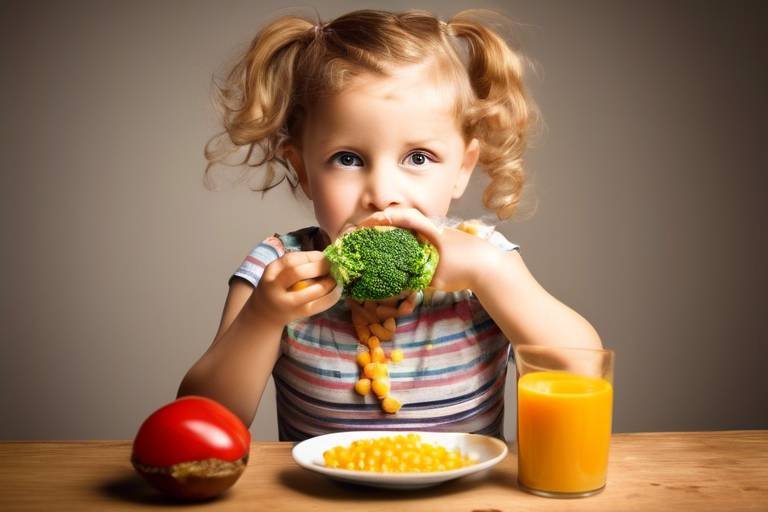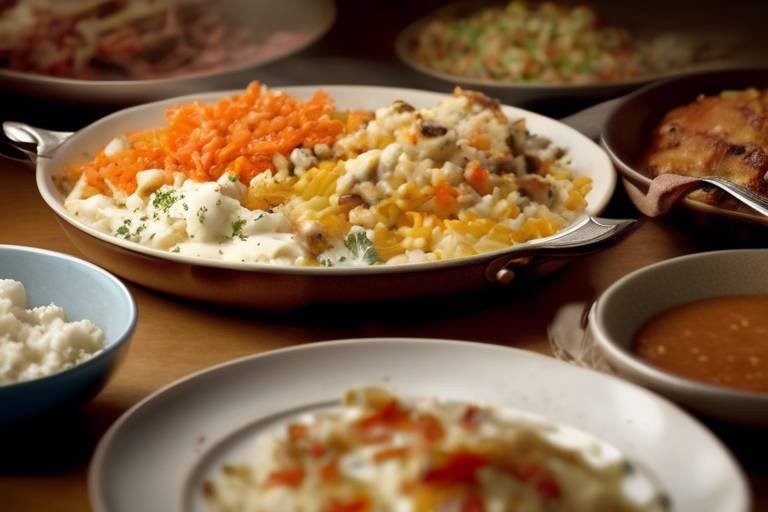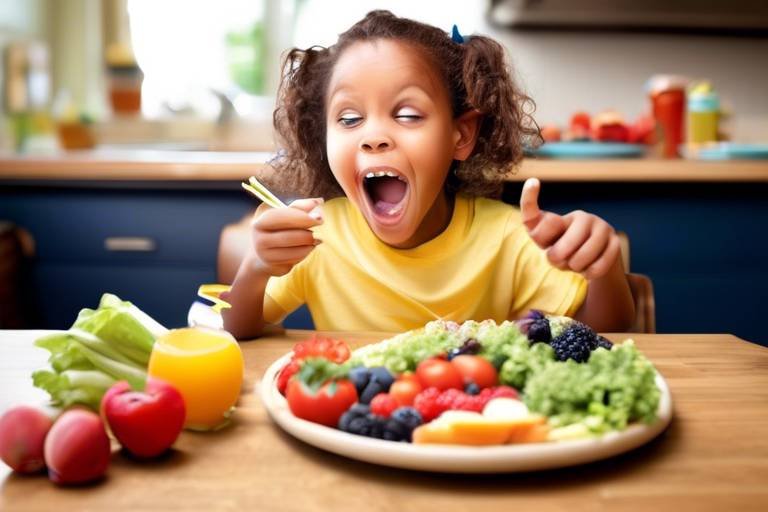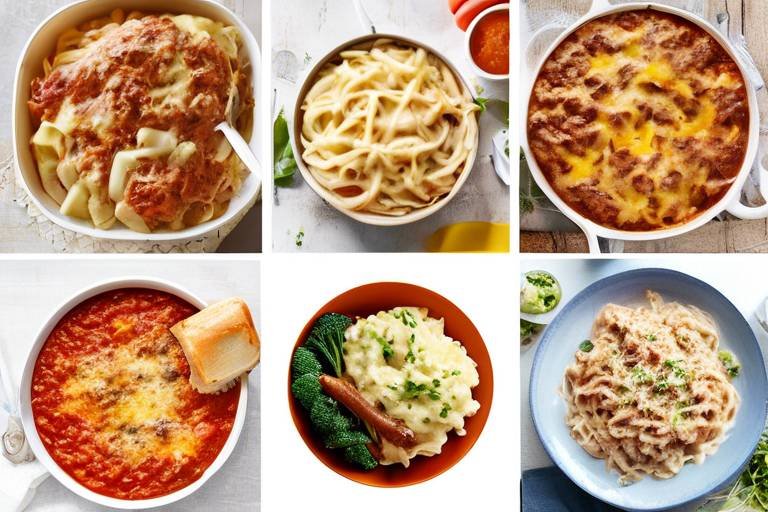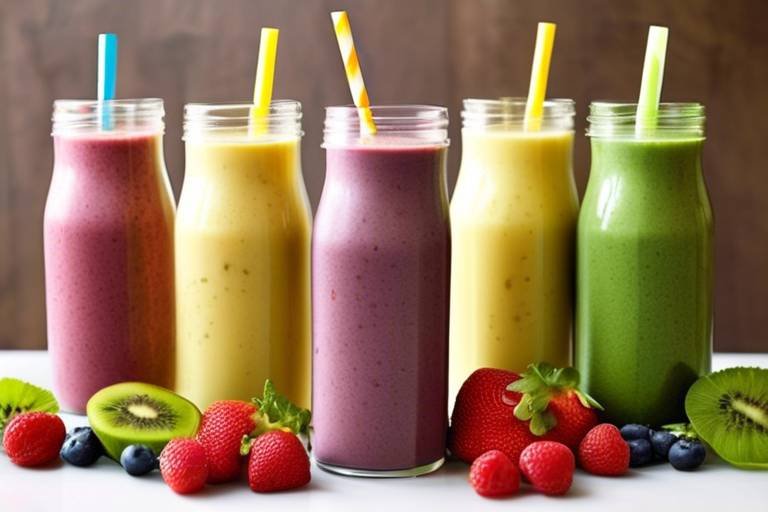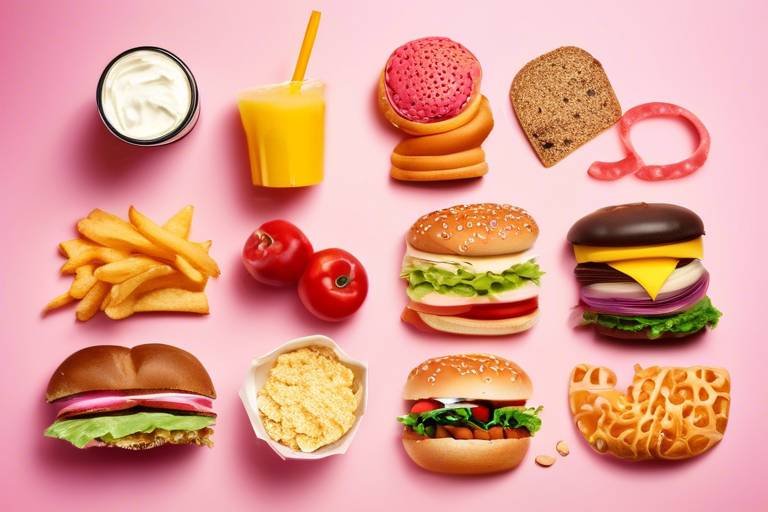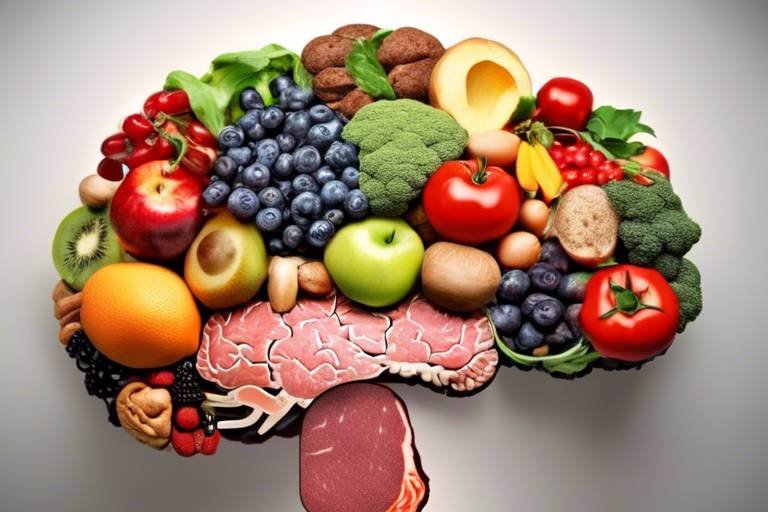Finding Alternative Sources of Protein for Vegetarian Kids
In today's world, where dietary choices are becoming increasingly diverse, many parents are opting for vegetarian diets for their children. However, one of the most common concerns is ensuring that these little ones get enough protein to support their growth and development. This article will explore various alternative sources of protein that are not only nutritious but also delicious for vegetarian kids. After all, a well-balanced diet is crucial for their energy levels, cognitive development, and overall health.
So, what exactly is protein, and why is it so important? Protein plays a vital role in building and repairing tissues, making enzymes and hormones, and supporting immune function. For children, protein is especially critical as they are in a constant state of growth. The challenge lies in finding suitable protein sources that fit within a vegetarian diet. Thankfully, there are plenty of options available that can make meal planning both fun and nutritious!
First and foremost, understanding the specific protein needs of vegetarian children is essential. Children aged 1 to 3 require about 13 grams of protein daily, while those aged 4 to 8 need around 19 grams. As they grow older, their protein needs increase, reaching about 34 grams for children aged 9 to 13. This can seem daunting, but with a little creativity, meeting these needs can be quite simple.
Incorporating a variety of plant-based protein sources into meals is key. Think of legumes, nuts, seeds, and whole grains as the building blocks of a vegetarian diet. These foods not only provide protein but also come packed with other essential nutrients. For instance, legumes like lentils and chickpeas are not only rich in protein but also high in fiber, promoting healthy digestion.
Now, let's dive deeper into some specific protein sources:
As we mentioned earlier, the protein requirements for vegetarian children can vary based on their age and activity level. This means that parents should pay close attention to their child's diet, ensuring that it includes a variety of protein-rich foods. A balanced plate should consist of different food groups, and this is where creativity comes into play. For example, a simple stir-fry can be packed with tofu, a great source of protein, alongside colorful vegetables.
When considering plant-based protein sources, there are several options that can easily be integrated into daily meals. Here’s a quick look at some of the best choices:
| Source | Protein Content (per 100g) | Other Nutrients |
|---|---|---|
| Lentils | 9g | Fiber, Iron, Folate |
| Chickpeas | 8.9g | Fiber, Manganese, Folate |
| Quinoa | 4.1g | Fiber, Magnesium, Iron |
| Almonds | 21g | Healthy Fats, Vitamin E |
| Chia Seeds | 17g | Omega-3 Fatty Acids, Fiber |
As you can see, these protein sources provide not just protein but a wealth of other nutrients that are essential for a child's growth. Incorporating these foods into meals can be as simple as adding chickpeas to a salad or sprinkling chia seeds on yogurt.
Legumes, such as lentils and beans, are some of the best protein sources available. They are incredibly versatile and can be used in various dishes. For instance, a hearty lentil soup can be a comforting meal, while chickpea salad can make for a refreshing lunch. Not only are they rich in protein, but they also come packed with fiber, which aids digestion and keeps kids feeling full longer.
Here are a couple of easy recipes that can make legumes appealing to kids:
- Lentil Tacos: Use lentils as a filling for tacos, topped with avocado and salsa.
- Chickpea Nuggets: Blend chickpeas with breadcrumbs and spices, bake until crispy for a fun snack!
Pulses not only provide protein but also offer numerous health benefits. They can help improve digestion, lower cholesterol levels, and even stabilize blood sugar levels. This makes them an excellent choice for vegetarian kids who need sustained energy throughout the day.
Nuts and seeds are another fantastic source of protein, packed with healthy fats that are essential for brain development. They can be enjoyed as snacks, added to smoothies, or sprinkled over salads. For example, almond butter on whole-grain toast or sunflower seeds in a trail mix can make for tasty and nutritious options!
Ensuring a varied diet is crucial for vegetarian kids. Different protein sources provide essential amino acids and nutrients that are important for their overall health. By mixing and matching different foods, parents can create balanced meals that keep their children excited about eating.
Combining different protein sources can help create complete proteins. For example, pairing rice and beans or peanut butter and whole-grain bread ensures that kids receive all the essential amino acids necessary for their growth and development. This simple practice can make a significant difference in their nutritional intake.
Making protein-rich foods fun and appealing is a great way to encourage kids to enjoy their meals. For instance, create colorful smoothie bowls topped with nuts and seeds, or prepare a DIY taco bar where kids can assemble their own tacos with various protein options. The more involved they are in the process, the more likely they are to eat what’s on their plate!
Q: Can vegetarian kids get enough protein without meat?
A: Absolutely! With a variety of plant-based protein sources, vegetarian kids can easily meet their protein needs.
Q: What are some quick protein-rich snacks for kids?
A: Consider options like nut butter on whole-grain crackers, yogurt with seeds, or hummus with veggies.
Q: How can I ensure my child is getting enough nutrients on a vegetarian diet?
A: Focus on a diverse diet that includes fruits, vegetables, whole grains, and various protein sources to ensure balanced nutrition.

Understanding Protein Needs
When it comes to raising vegetarian children, one of the most pressing concerns for parents is ensuring their little ones get enough protein. Protein is crucial for growth, development, and overall health, especially in children who are still in their formative years. So, what exactly are the protein needs for vegetarian kids? Well, it varies by age, activity level, and individual health requirements. For instance, toddlers may require around 13 grams of protein daily, while teenagers might need up to 52 grams or more. It's essential to pay attention to these numbers to ensure your child is thriving.
Understanding these needs is not just about meeting a number; it’s about providing a balanced diet that includes a variety of protein sources. Vegetarian diets can be rich in protein if you know where to look. Think of it like a puzzle—each piece plays a role in creating a complete picture of nutrition. For vegetarian kids, this means combining different protein sources to ensure they get all the essential amino acids their bodies need.
But how can you ensure your child meets their protein requirements? Here are a few key points to keep in mind:
- Age Matters: As mentioned, protein needs vary significantly with age. For example, school-aged children typically need around 19 grams of protein per day.
- Active Lifestyle: If your child is active in sports or other physical activities, they may require more protein to support muscle growth and recovery.
- Quality Over Quantity: It's not just about the amount of protein; the quality matters too. Focus on whole food sources rather than processed protein products.
To help visualize these requirements, here’s a simple table that outlines the recommended daily protein intake for children based on age:
| Age Group | Recommended Protein Intake (grams) |
|---|---|
| 1-3 years | 13 grams |
| 4-8 years | 19 grams |
| 9-13 years | 34 grams |
| 14-18 years | 46-52 grams |
Incorporating a variety of protein-rich foods into your child's meals can be fun and creative. Think of colorful smoothies with nut butters, hearty soups loaded with legumes, or even snacks like hummus and veggies. The key is to keep it interesting and flavorful, so your kids are excited to eat their protein!
In summary, understanding the protein needs of vegetarian children is vital for their growth and well-being. By focusing on age-specific requirements and incorporating a diverse array of protein sources, you can help ensure your child is not only meeting their nutritional needs but also enjoying their meals. Remember, a well-fed child is a happy child!

Plant-Based Protein Sources
When it comes to ensuring that vegetarian kids get enough protein, the options are plentiful and exciting! A plant-based diet can be a vibrant palette of flavors and textures, bursting with nutrients. It's not just about avoiding meat; it’s about embracing a world of delicious alternatives. From legumes to whole grains, there are numerous sources of protein that can be easily integrated into your child's meals. Let’s dive into some of the best plant-based protein sources that can help fuel their growing bodies!
One of the most versatile groups of protein sources comes from legumes and pulses. These include lentils, chickpeas, black beans, and kidney beans. Not only are they rich in protein, but they also pack a punch of fiber, which is essential for a healthy digestive system. Imagine a warm bowl of lentil soup or a vibrant chickpea salad; these dishes can be both nutritious and appealing to kids. The best part? They can be easily incorporated into various meals, making it fun for children to explore new flavors.
Next up are nuts and seeds. These tiny powerhouses are loaded with protein and healthy fats, which are crucial for brain development. Think about adding a sprinkle of chia seeds to a smoothie or tossing some almonds into a trail mix. The crunch and flavor can make a simple snack feel like a treat! Plus, they can be blended into nut butters, which can be spread on whole-grain bread or used as a dip for fruits. The possibilities are endless!
Another fantastic source of protein is whole grains. Foods like quinoa, brown rice, and oats not only provide protein but also essential vitamins and minerals. Quinoa, in particular, is a complete protein, meaning it contains all nine essential amino acids that the body cannot produce on its own. You can whip up a delicious quinoa salad with colorful veggies or serve it as a side dish with your main meal. It’s a simple yet effective way to boost protein intake!
To show just how rich these plant-based protein sources can be, here’s a quick comparison of some common options:
| Protein Source | Protein Content (per 100g) | Other Nutrients |
|---|---|---|
| Lentils | 9g | Fiber, Iron, Folate |
| Chickpeas | 8.9g | Fiber, Manganese, Phosphorus |
| Quinoa | 4.1g | Fiber, Magnesium, B Vitamins |
| Almonds | 21.2g | Vitamin E, Magnesium, Healthy Fats |
| Chia Seeds | 16.5g | Omega-3 Fatty Acids, Fiber, Calcium |
Incorporating these protein sources into your child's diet can be both easy and enjoyable. Try mixing different sources to create meals that are not only nutritious but also visually appealing. For instance, a colorful grain bowl topped with chickpeas, avocado, and a sprinkle of seeds can be a feast for the eyes as well as the tummy!
Ultimately, the key to a successful vegetarian diet for kids is variety. By introducing a wide range of plant-based proteins, you ensure they receive all the essential amino acids needed for their growth and development. So, let your creativity flow in the kitchen, and watch as your kids discover the joy of healthy eating!
- What are some easy ways to include protein in my child's vegetarian diet? You can start by incorporating legumes, nuts, seeds, and whole grains into meals and snacks. Smoothies, salads, and wraps are great ways to sneak in protein!
- How much protein do vegetarian kids need? Protein needs vary by age, but generally, children aged 1-3 need about 13g per day, while those aged 4-8 need around 19g. Older children may need more, so it's essential to balance their meals accordingly.
- Can vegetarian kids get enough protein without meat? Absolutely! With a well-planned diet that includes a variety of plant-based protein sources, vegetarian kids can meet their protein needs effectively.

Legumes and Pulses
When it comes to providing nutritional powerhouses for vegetarian kids, legumes and pulses are truly in a league of their own! These little gems, which include lentils, chickpeas, and various types of beans, are not only rich in protein but also packed with fiber, vitamins, and minerals. Imagine a food that fuels your child's growth while also supporting their digestive health—sounds like a win-win, right?
Legumes are incredibly versatile and can be incorporated into a wide range of dishes. For instance, a hearty lentil soup can be a comforting meal on a chilly evening, while a chickpea salad can add a refreshing twist to lunch. The beauty of legumes lies in their ability to absorb flavors, making them perfect for experimenting with different spices and herbs. You can even sneak them into smoothies or sauces for a protein boost without altering the taste significantly!
To give you a better idea of how legumes can fit into your child’s diet, here’s a quick overview of some popular options:
| Type of Legume | Protein Content (per cooked cup) | Other Nutritional Benefits |
|---|---|---|
| Lentils | 18 grams | High in iron, folate, and fiber |
| Chickpeas | 15 grams | Rich in manganese, phosphorus, and healthy fats |
| Black Beans | 15 grams | Good source of antioxidants and fiber |
Now, you might be wondering, "How can I make legumes appealing to my picky eater?" The answer lies in creativity! Try making vegetable-packed burritos with black beans, or whip up a batch of chickpea nuggets that can be baked and served with a fun dipping sauce. The more you experiment, the more likely your child will find a way to enjoy these nutritious foods.
Beyond just being a source of protein, legumes and pulses offer numerous health benefits. They can help regulate blood sugar levels, reduce cholesterol, and improve heart health. Plus, the fiber content promotes a healthy digestive system, which is crucial for growing kids. With all these advantages, it’s clear that incorporating legumes into your child’s diet is not just a good idea—it's essential!
In summary, legumes and pulses are a fantastic way to ensure that your vegetarian kids are getting the protein they need. By being innovative with recipes and incorporating these foods into their meals, you can help your children develop a love for nutritious eating that will last a lifetime.
- How can I introduce legumes to my child's diet? Start with familiar dishes, like adding lentils to spaghetti sauce or chickpeas to salads. Gradually increase their presence in meals.
- Are canned legumes as nutritious as dried? Yes, canned legumes are convenient and nutritious. Just be sure to rinse them to reduce sodium content.
- Can legumes cause digestive issues? Some children may experience gas when first introducing legumes. Start with small amounts and gradually increase to help their digestive system adjust.

Recipes with Legumes
When it comes to feeding vegetarian kids, legumes are a fantastic option, not just for their nutritional value but also for their versatility in cooking. Let’s dive into some delicious and easy recipes that will make legumes the star of the meal, ensuring your little ones enjoy their protein without even realizing it!
One of the simplest and most loved recipes is the classic Chickpea Salad. To prepare this, simply combine canned chickpeas (drained and rinsed) with diced cucumbers, cherry tomatoes, and bell peppers. Add a splash of olive oil, a squeeze of lemon juice, and sprinkle with salt and pepper. This vibrant salad is not only packed with protein but also a feast for the eyes!
For something warm and comforting, try making Lentil Soup. Start by sautéing onions, carrots, and celery in a pot until they soften. Then, add rinsed lentils, vegetable broth, and your choice of spices—think cumin, paprika, or even a dash of chili powder for a kick! Let it simmer until the lentils are tender. This soup is perfect for chilly days and is sure to fill up those hungry bellies.
If your kids are fans of pasta, you can whip up a Black Bean Pasta. Cook whole wheat pasta according to package instructions, then toss it with black beans, corn, diced tomatoes, and avocado. Drizzle with a homemade lime vinaigrette for an extra zing! Not only does this dish provide a good amount of protein, but it also incorporates healthy fats from the avocado.
Another fun recipe is Bean Burgers. Mash cooked black beans or kidney beans and mix them with breadcrumbs, finely chopped onions, and spices. Form into patties and pan-fry until crispy. Serve on whole grain buns with all the fixings—lettuce, tomato, and maybe even a slice of cheese. Kids will love the taste, and you’ll love how easy it is to sneak in some extra protein!
Finally, a great snack option is Hummus. Blend chickpeas, tahini, garlic, lemon juice, and olive oil until smooth. Serve with carrot sticks, cucumber slices, or whole grain pita bread. This dip not only satisfies hunger but also provides a creamy, delicious way to enjoy legumes.
Incorporating these recipes into your child’s diet can make a world of difference. Legumes are not just a source of protein; they bring fiber, vitamins, and minerals to the table. So, get creative in the kitchen, and watch as your kids embrace these healthy, protein-packed meals!
Q: How can I ensure my vegetarian child gets enough protein?
A: Incorporate a variety of protein sources like legumes, nuts, seeds, and whole grains into their meals. Combining different sources can also help provide all essential amino acids.
Q: Are legumes safe for young children?
A: Yes, legumes are safe and healthy for children. Just ensure they are cooked properly to make them easier to digest.
Q: How can I introduce legumes to my picky eater?
A: Start with small amounts mixed into their favorite dishes, like adding lentils to spaghetti sauce or blending chickpeas into smoothies. Gradually increase the amount as they get used to the taste.

Health Benefits of Pulses
Pulses, which include lentils, chickpeas, and various types of beans, are not just a fantastic source of protein; they also pack a punch when it comes to health benefits. For vegetarian kids, incorporating pulses into their diet is a game-changer. Why? Because these tiny powerhouses are loaded with essential nutrients that contribute significantly to overall health and development.
First off, pulses are rich in fiber. This is crucial for children as it aids in digestion and helps maintain a healthy gut. A diet high in fiber can prevent constipation, which is a common issue among kids. Plus, fiber helps in keeping them feeling full longer, reducing the likelihood of unhealthy snacking. Imagine a kid who is satisfied after a hearty lentil soup rather than reaching for sugary snacks!
Moreover, pulses are an excellent source of vitamins and minerals. They are packed with iron, which is vital for energy levels and cognitive function. For vegetarian kids, who may not get enough iron from meat sources, pulses can bridge that gap effectively. Additionally, they contain essential nutrients like potassium, magnesium, and folate, all of which support a child's growth and development.
Another remarkable benefit of pulses is their ability to support heart health. Studies have shown that regular consumption of pulses can help lower cholesterol levels, thanks to their high fiber content and low saturated fat levels. This is particularly important as heart disease risk factors can begin early in life.
To illustrate the health benefits of pulses, consider the following table:
| Pulse Type | Protein (per 100g) | Fiber (per 100g) | Key Nutrients |
|---|---|---|---|
| Lentils | 9g | 8g | Iron, Folate |
| Chickpeas | 8.9g | 7.6g | Magnesium, Potassium |
| Black Beans | 8.9g | 8.7g | Folate, Iron |
Incorporating pulses into meals can be fun and delicious! You can blend them into smoothies, toss them in salads, or create hearty stews. The versatility of pulses means they can be adapted to various cuisines, making them a great addition to any meal. For instance, a chickpea salad with colorful veggies can be a hit at lunchtime, while lentil soup can warm them up on a chilly day.
Lastly, pulses are not only nutritious but also environmentally friendly. They require less water and energy to produce compared to animal protein sources, making them a sustainable choice. Teaching kids about the benefits of pulses can instill a sense of responsibility toward their health and the planet.
In conclusion, pulses are a fantastic addition to the diets of vegetarian kids. Their numerous health benefits, coupled with their versatility and sustainability, make them an essential component of a balanced diet. So next time you're planning meals, remember to include these little nutritional powerhouses!

Nuts and Seeds
Nuts and seeds are not just crunchy snacks; they are powerhouses of nutrition for vegetarian kids! Packed with protein, healthy fats, vitamins, and minerals, these tiny morsels can significantly contribute to a balanced diet. Imagine nuts as the tiny superheroes of the food world—each one brings its unique set of nutrients to the table, helping kids grow strong and healthy. But how can you make sure your little ones are getting enough of these nutritious foods?
First, let’s talk about some popular options. Nuts like almonds, walnuts, and cashews are not only delicious but also high in protein. For instance, almonds contain about 6 grams of protein per ounce, making them a fantastic snack choice. On the other hand, seeds such as chia, flaxseed, and pumpkin seeds are equally impressive. Chia seeds, for example, provide about 5 grams of protein per ounce and are also rich in omega-3 fatty acids, which are great for brain development.
Incorporating nuts and seeds into your children's meals can be both fun and easy. Here are some creative ideas to get you started:
- Add nuts to smoothies: Blend a handful of almonds or walnuts into your child's favorite smoothie for an extra protein boost.
- Make energy balls: Combine oats, nut butter, honey, and seeds to create delicious energy bites that are perfect for snacks.
- Sprinkle seeds on salads: Add pumpkin or sunflower seeds to salads for a crunchy texture and added nutrition.
But wait, there’s more! Nuts and seeds can also be used in baking. Imagine a warm, fresh batch of banana bread with walnuts or a batch of cookies sprinkled with chia seeds. Not only do they enhance the flavor, but they also boost the protein content, making treats that are both enjoyable and nutritious.
It's important to remember that while nuts and seeds are healthy, they should be consumed in moderation, especially with younger children, due to their high-calorie nature and potential choking hazards. Always ensure nuts are chopped or ground for younger kids to make them safer to consume.
So, if you're looking to enrich your vegetarian child's diet, don’t overlook the benefits of nuts and seeds. They are versatile, nutritious, and can be easily incorporated into various meals and snacks, making them an essential part of a balanced vegetarian diet.
Q: Can my child be allergic to nuts?
A: Yes, nut allergies are common. Always consult with a pediatrician before introducing nuts into your child's diet, especially if there is a family history of allergies.
Q: How can I ensure my child gets enough protein from a vegetarian diet?
A: Combine various protein sources such as legumes, nuts, seeds, and whole grains to create balanced meals. It's all about variety!
Q: Are there any nut alternatives for kids with allergies?
A: Absolutely! Seeds like sunflower and pumpkin seeds can be great alternatives, and seed butters can replace nut butters in recipes.

Importance of Variety
When it comes to a vegetarian diet for kids, variety is not just the spice of life; it's the foundation of their health. Just like a colorful garden thrives on diverse plants, children need a wide array of foods to flourish. A varied diet ensures that they receive all the essential nutrients required for their growth and development. Think of it this way: if you were to eat the same meal every day, it would quickly become boring, right? The same goes for kids. If their meals lack variety, not only will they lose interest, but they may also miss out on vital nutrients.
Incorporating different sources of protein into their meals is crucial. Each protein source has a unique profile of amino acids, vitamins, and minerals. For instance, legumes, nuts, seeds, and whole grains all contribute differently to a child’s nutritional needs. By mixing things up, you can ensure that your little ones are getting a balanced intake of nutrients. For example, combining beans with rice provides a complete protein, meaning it contains all the essential amino acids that growing bodies need.
Moreover, a varied diet can also help in preventing food allergies. Introducing a range of foods can build a child's tolerance and reduce the risk of developing sensitivities. It’s like giving them a taste of the world! From the earthy flavors of lentils to the crunchy goodness of nuts, each bite can be an adventure.
To illustrate the importance of variety, consider the following table that outlines the protein content and benefits of different vegetarian sources:
| Protein Source | Protein Content (per 100g) | Key Nutrients |
|---|---|---|
| Lentils | 9g | Iron, Folate |
| Chickpeas | 19g | Magnesium, Fiber |
| Almonds | 21g | Vitamin E, Healthy Fats |
| Quinoa | 4g | Complete Protein, Magnesium |
As you can see, each of these protein sources offers something unique, making it essential to include a variety in your child’s diet. Not only does this approach support their physical health, but it also encourages adventurous eating habits. Kids who are exposed to a range of flavors and textures are more likely to develop a love for healthy foods, setting the stage for a lifetime of good eating habits.
In summary, embracing variety in a vegetarian diet for kids is like painting a masterpiece; every color, or in this case, every food group, adds depth and richness to their overall health. So, don’t be afraid to experiment in the kitchen! Mix, match, and create colorful plates that will not only nourish their bodies but also excite their taste buds.
Q: How can I ensure my vegetarian child gets enough protein?
A: Incorporate a variety of protein sources such as legumes, nuts, seeds, and whole grains into their meals. Combining different sources can help provide complete proteins.
Q: What are some easy ways to introduce new protein sources to my child?
A: Start by mixing new foods with familiar ones. For example, add chickpeas to a pasta salad or use lentils in a soup. Make it fun by letting them help in the kitchen!
Q: Are there any risks associated with a vegetarian diet for children?
A: As long as the diet is well-planned and includes a variety of foods, there are minimal risks. However, it's essential to ensure they receive adequate nutrients, particularly protein, iron, and vitamin B12.

Combining Protein Sources
When it comes to ensuring that vegetarian kids get all the essential amino acids they need for growth and development, is a game-changer. Unlike animal proteins, which are considered complete proteins, many plant-based proteins are incomplete, meaning they lack one or more of the essential amino acids. But don’t worry! By combining different protein sources, you can create complete proteins that provide everything your child needs.
For example, pairing legumes with grains is a fantastic way to achieve this. Think of a classic dish like rice and beans. Here, the amino acids in rice complement those in beans, creating a balanced meal that’s not only nutritious but also delicious. Other combinations that work well include:
- Peanut butter on whole grain bread: The nuts provide healthy fats and protein, while the whole grains add fiber and additional protein.
- Lentil soup with whole grain crackers: This combo offers a hearty dose of protein and fiber, perfect for a filling meal.
- Chickpea salad with quinoa: Both ingredients are rich in protein and provide a variety of nutrients.
Additionally, it’s essential to consider the timing and variety of these combinations. By incorporating a mix of different protein sources throughout the day, you can ensure that your child receives a well-rounded intake of amino acids. For instance, a breakfast of oatmeal topped with nuts and seeds can set a solid foundation, while a lunch of hummus with whole grain pita and veggies can keep the momentum going.
Moreover, it’s not just about the protein; these combinations often come with added benefits like fiber, vitamins, and minerals, which are crucial for overall health. For instance, legumes are not only high in protein but also packed with fiber that aids in digestion and keeps kids feeling full longer. When combined with grains, they create a meal that fuels their energy needs throughout the day.
To make it even more fun, involve your kids in the kitchen! Let them help with meal prep and choose their favorite combinations. Not only does this encourage them to try new foods, but it also teaches them about nutrition in a hands-on way. Remember, the goal is to make protein-rich meals enjoyable and satisfying, so get creative with colors, textures, and flavors!
In summary, combining protein sources is a simple yet effective way to ensure that vegetarian kids receive all the essential nutrients they need. By mixing and matching various legumes, grains, nuts, and seeds, you can create a colorful, balanced diet that supports their growth and keeps mealtime exciting!

Fun Ways to Serve Protein
Getting kids excited about their meals can sometimes feel like a Herculean task, especially when it comes to ensuring they consume enough protein. But fear not! There are plenty of creative and fun ways to serve protein that will not only satisfy their taste buds but also make mealtime an enjoyable adventure. Imagine transforming a simple meal into a colorful masterpiece that sparks curiosity and excitement!
One fantastic way to serve protein is by incorporating it into colorful wraps. Take a whole grain tortilla and fill it with a delightful mix of hummus, shredded carrots, spinach, and black beans. Roll it up and slice it into pinwheels for a fun finger food option that kids can easily grab and munch on. Not only do these wraps look appealing, but they are also packed with protein and nutrients!
Another playful idea is to create a DIY protein bar station. Set out a variety of ingredients such as oats, nut butters, seeds, and dried fruits. Let the kids mix and match their favorite ingredients to create their own personalized protein bars. This not only encourages creativity but also allows them to take ownership of their food choices. Plus, they’ll love the satisfaction of enjoying something they made themselves!
For a delightful twist on traditional meals, consider making protein-packed smoothies. Blend together fruits, spinach, and a scoop of protein powder or Greek yogurt for a creamy treat that’s both nutritious and delicious. You can even let the kids choose their favorite fruits and watch as they become little smoothie chefs. Serve these colorful concoctions in fun cups with silly straws to make them even more enticing!
Don’t forget about the power of fun shapes! Use cookie cutters to create fun shapes out of tofu, cheese, or even whole grain bread. Kids are often more willing to try new foods when they’re presented in a fun and exciting way. Pair these shapes with a tasty dip, like guacamole or a yogurt-based dressing, to make them even more appealing. It’s amazing how a little creativity can transform the ordinary into the extraordinary!
Lastly, consider hosting a “Protein Party” where kids can taste-test different protein-rich foods. Set up a tasting table with various options like roasted chickpeas, nut mixes, and edamame. Encourage them to rate each item on a scale from one to ten. This interactive experience not only familiarizes them with different protein sources but also makes them more likely to enjoy these foods in the future. Who knew that protein could be so much fun?
Incorporating protein into your child's diet doesn't have to be a chore. With a little creativity and imagination, you can turn mealtime into a delightful experience that leaves them asking for more! By serving protein in fun and engaging ways, you’ll not only meet their nutritional needs but also foster a love for healthy eating.
- What are some quick protein-rich snacks for kids?
Some great options include yogurt with fruit, nut butter on whole grain crackers, or homemade trail mix with nuts and seeds.
- How can I ensure my vegetarian child is getting enough protein?
By incorporating a variety of protein sources like legumes, nuts, seeds, and dairy products into their meals, you can easily meet their protein needs.
- Are there any protein-rich breakfast ideas?
Absolutely! Consider oatmeal topped with nut butter and banana, or a smoothie made with spinach, yogurt, and protein powder.
Frequently Asked Questions
- What are the protein needs for vegetarian kids?
Vegetarian kids have specific protein requirements that vary by age. Generally, children aged 1-3 need about 13 grams of protein daily, while those aged 4-8 require around 19 grams. As they grow older, the needs increase, with kids aged 9-13 needing about 34 grams. It's crucial to ensure they get enough protein through a balanced diet rich in diverse sources.
- What are some good plant-based protein sources?
There are plenty of delicious plant-based protein sources to consider! Legumes like lentils, chickpeas, and beans are fantastic options, as are nuts and seeds. Whole grains like quinoa and brown rice also pack a protein punch. Incorporating a variety of these foods into meals can help vegetarian kids meet their protein needs while keeping things interesting and tasty.
- How can I make legumes more appealing to my kids?
Making legumes appealing to kids can be a fun challenge! You can try incorporating them into soups, salads, or even making tasty dips like hummus. Additionally, adding spices and herbs can enhance their flavor, making them more enjoyable. Creative recipes like lentil tacos or chickpea nuggets can turn legumes into a family favorite!
- Are nuts and seeds safe for kids?
Nuts and seeds are generally safe for kids, but it's important to be aware of allergies. If there are no allergy concerns, they can be great sources of protein and healthy fats. Just remember to choose age-appropriate sizes and textures—like nut butters or finely chopped nuts—to prevent choking hazards for younger children.
- How can I ensure my kids get all essential amino acids?
Combining different protein sources is key to ensuring vegetarian kids get all essential amino acids. For example, pairing rice with beans or whole grain bread with peanut butter creates a complete protein. Mixing and matching various sources throughout the day can help achieve a balanced intake of amino acids necessary for growth and development.
- What are some fun ways to serve protein-rich foods?
Serving protein-rich foods in fun and creative ways can make mealtime exciting! Try making colorful protein-packed smoothies, or create a DIY snack bar with nuts, seeds, and dried fruits. You can also use cookie cutters to shape protein-rich foods like tofu or whole grain bread into fun shapes, making them more appealing to kids.

